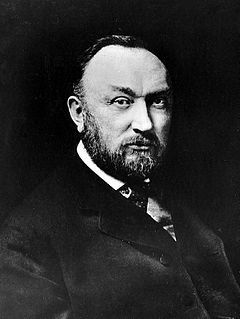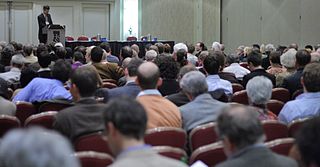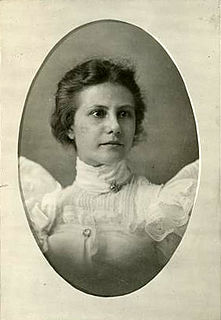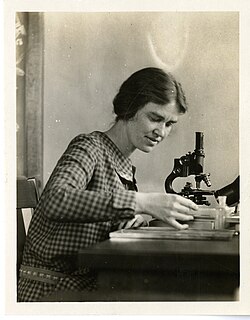
Williamina Paton Stevens Fleming was a Scottish astronomer active in the United States. During her career, she helped develop a common designation system for stars and cataloged thousands of stars and other astronomical phenomena. Among several career achievements that advanced astronomy, Fleming is noted for her discovery of the Horsehead Nebula in 1888.

Edward Charles Pickering was an American astronomer and physicist and the older brother of William Henry Pickering. Along with Carl Vogel, Pickering discovered the first spectroscopic binary stars. He wrote Elements of Physical Manipulations.

The History of Science Society (HSS) is the primary professional society for the academic study of the history of science. It was founded in 1924 by George Sarton, David Eugene Smith, and Lawrence Joseph Henderson, primarily to support the publication of Isis, a journal of the history of science Sarton had started in 1912. The society has over 3,000 members worldwide. It continues to publish the quarterly journal Isis, the yearly Osiris, sponsors the IsisCB: History of Science Index, and holds an annual conference.

The presence of women in science spans the earliest times of the history of science wherein they have made significant contributions. Historians with an interest in gender and science have researched the scientific endeavors and accomplishments of women, the barriers they have faced, and the strategies implemented to have their work peer-reviewed and accepted in major scientific journals and other publications. The historical, critical, and sociological study of these issues has become an academic discipline in its own right.

Mary Watson Whitney was an American astronomer and for 22 years the head of the Vassar Observatory where 102 scientific papers were published under her guidance.
Harriet Anne Zuckerman is an American sociologist and professor emerita of Columbia University. Zuckerman specializes in the sociology of science. She is known for her work on the social organization of science, scientific elites, the accumulation of advantage, the Matthew effect, and the phenomenon of multiple discovery.

Reproductive synchrony is a term used in evolutionary biology and behavioral ecology. Reproductive synchrony—sometimes termed "ovulatory synchrony"—may manifest itself as "breeding seasonality". Where females undergo regular menstruation, "menstrual synchrony" is another possible term.
Women in geology concerns the history and contributions of women to the field of geology. There has been a long history of women in the field, but they have tended to be under-represented. In the era before the eighteenth century, science and geological science had not been as formalized as they would become later. Hence early geologists tended to be informal observers and collectors, whether they were male or female. Notable examples of this period include Hildegard of Bingen who wrote works concerning stones and Barbara Uthmann who supervised her husband's mining operations after his death. Mrs. Uthmann was also a relative of Georg Agricola. In addition to these names varied aristocratic women had scientific collections of rocks or minerals.

The Harvard Computers was a team of women working as skilled workers to process astronomical data at the Harvard Observatory in Cambridge, Massachusetts, United States. The team was directed by Edward Charles Pickering and, following his death in 1919, by Annie Jump Cannon.

The Matilda effect is a bias against acknowledging the achievements of women scientists whose work is attributed to their male colleagues. This phenomenon was first described by suffragist and abolitionist Matilda Joslyn Gage (1826–98) in her essay, "Woman as Inventor". The term "Matilda effect" was coined in 1993 by science historian Margaret W. Rossiter.
Margaret W. Rossiter is an American historian of science, and Marie Underhill Noll Professor of the History of Science, at Cornell University. Rossiter coined the term Matilda effect for the systematic suppression of information about women in the history of science, and the denial of the contribution of women scientists in research, whose work is often attributed to their male colleagues.
Queen bee syndrome is a phenomenon first defined by C. Tavris, G.L. Staines, and T.E. Jayaratne in 1973. “Queen bee” is a derogatory term applied to women who have achieved success in traditionally male-dominated fields. These women often take on “masculine” traits and distance themselves from other women in the workplace in order to succeed. They may also view or treat subordinates more critically if they are female, and refuse to help other women rise up the ranks as a form of self-preservation.

Clara Henriette Hasse was an American botanist whose research focused on plant pathology. She is known for identifying the cause of citrus canker, which was threatening crops in the Deep South.

Many scholars and policymakers have noted that the fields of science, technology, engineering, and mathematics (STEM) have remained predominantly male with historically low participation among women since the origins of these fields in the 18th century during the Age of Enlightenment.

Erwin Frink Smith was an American plant pathologist with the United States Department of Agriculture. He played a major role in demonstrating that bacteria could cause plant disease.
Effie Almira Southworth Spalding (1860–1947), was an American botanist and mycologist, and the first woman plant pathologist hired by the United States Department of Agriculture (USDA). Her most important discovery was the 1887 identification of the fungus Colletotrichum gossypii as the cause of cotton cankers, a disease which killed thousands of acres of cotton and was a major economic threat. She taught botany at several institutions, worked at the Desert Botanical Laboratory with her husband, and established the Botany Department Herbarium at the University of Southern California.
Ann Hibner Koblitz is a Professor Emerita of Women and Gender Studies at Arizona State University known for her studies of the history of women in science. She is the Director of the Kovalevskaia Fund, which supports women in science in developing countries.

This is a timeline of women in science, spanning from ancient history up to the 21st century. While the timeline primarily focuses on women involved with natural sciences such as astronomy, biology, chemistry and physics, it also includes women from the social sciences and the formal sciences, as well as notable science educators and medical scientists. The chronological events listed in the timeline relate to both scientific achievements and gender equality within the sciences.

Margaret Campbell Mann Lesley (1891-1988) was an American cytologist and geneticist who specialized in plant breeding cytogenetics. Her primary work focused on cytological analyses of tomatoes and citrus. She was an active research assistant to Howard B. Frost (1881-1969), an Associate Plant Breeder at the Citrus Experiment Station, and to James W. Lesley (1888-1982), her husband, whom she extensively collaborated and conducted research on tomato breeding.
Josephine Margaret Mitchell was a Canadian-American mathematician specializing in the mathematical analysis of functions of several complex variables. She was the victim of a notorious case of discrimination against women in academia when, after she married another more junior faculty member at the University of Illinois Urbana-Champaign, the university used its anti-nepotism rules to revoke her tenured position while allowing her husband to keep his untenured one.












